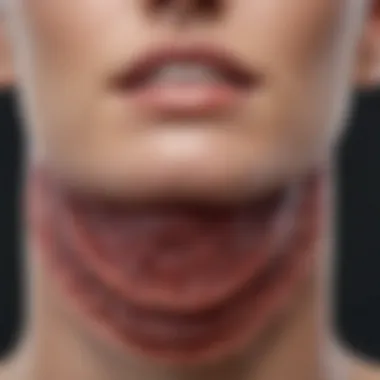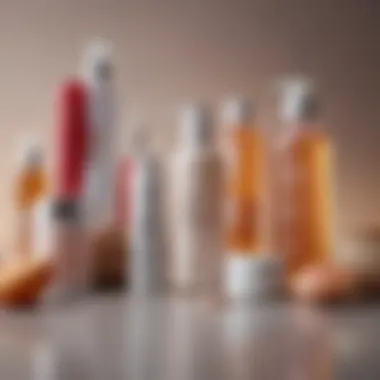How to Safely Pop a Pustule: A Complete Guide


Intro
Popping a pustule may seem trivial, yet it is a complex process surrounded by various considerations. Understanding what a pustule is and how to address it safely can make a significant difference in skin health. This comprehensive guide brings you the essential knowledge needed to confront this beauty concern competently. Here, we will outline the necessary steps as well as cautionary measures to mitigate risks associated with extractions.
Understanding Pustules
Pustules are inflamed, swollen bumps on the skin filled with pus. They form when hair follicles become clogged with excess oil and dead skin cells, resulting in a reaction from the body that produces inflammation and pus. Recognizing different types of acne can aid in choosing the correct approach for care. Thus, careful consideration of skin conditions will guide your choice on whether to pop a pustule or seek a professional.
Considerations Before Popping a Pustule
Before you consider piercing your skin to remove the pus, it's crucial to evaluate whether this is the right step. Think about:
- Current skin condition: Assess whether there are numerous pustules or if it's singular.
- Risk of scarring: Understand that improperly handled extractions can leave permanent marks on your skin.
- Hygiene standards: Ensure proper hygienic conditions to minimize exposure to bacteria.
It is also wise to consult a dermatologist if you are unsure or dealing with persistent acne issues.
Proper hygiene during the process cannot be overstated; your skin's health warrants thorough attention.
Preparation Steps
To prepare for the process, consider these essential elements:
- Clean your skin: Use a gentle cleanser to remove dirt and excess oil.
- Sterilize your tools: If using any tool for extraction, make sure it's completely sterilized to prevent infection.
- Choose the right time: End of the day after your skin has had left-over make up cleaned and proper nighttime skin care done may be the best option.
- Relax: Stress can contribute to acne flare-ups, take few deep breaths prior to the act.
These preparatory measures will help you minimize any potential areas of concern and create an environment conducive to safer extraction practices.
Continuing with details on hygiene and skin health will guide us to address the extraction process efficiently.
Understanding Pustules
Understanding pustules is crucial for anyone looking to manage their skin health effectively. Pustules, being visible and often distressing skin lesions, can affect one’s overall confidence. A deeper comprehension of their origin, structure, and types can empower individuals to take appropriate care measures, making informed decisions about popping them or seeking professional help.
Definition of Pustules
Pustules are small, elevated bumps on the skin that are filled with pus. They usually appear as inflammatory lesions characterized by a red base and a yellow or white-filled center. Pustules are commonly associated with acne but can occur in various skin conditions. Recognizing pustules requires distinguishing them from other types of acne lesions, as they indicate localized skin irritation and infection.
Causes of Pustule Formation
The formation of pustules can arise from several factors:
- Clogged pores: Excess oil and dead skin cells can obstruct pores, leading to inflammation.
- Bacterial infection: Propionibacterium acnes can multiply in blocked pores, resulting in pus accumulation.
- Hormonal changes: Fluctuations, especially during puberty or menstrual cycles, may trigger excess oil production.
- Poor skincare routines: Not cleansing the skin properly can exacerbate conditions leading to pustule development.
Understanding these causes is essential for preventive skin care and can save time and discomfort in managing outbreaks.
Types of Pustules
Pustules can vary in form and presentation. The most common types include:
- Infected pustules: Often red and swollen, may be painful. These are usually caused by bacterial infections.
- Non-infected pustules: Often less inflamed. While they still appear as raised bumps, they may resolve without significant intervention.
- Acne vulgaris pustules: Usually associated with common acne and might require tailored treatments.
Knowledge of these types aids in the proper identification and painful dispensation of pustules, adapting treatments for better outcomes.
Awareness of what constitutes a pustule not only helps one identify them correctly but also aids in streamlining subsequent care choices.
When to Consider Popping a Pustule
When it comes to skin care, the decision to pop a pustule should not be taken lightly. The right moment combined with accurate information is crucial in this process. Understanding the factors that indicate the appropriateness of popping a pustule can help you make informed choices that benefit your skin rather than harm it.


Inevitably, most people experience skin issues, including pustules. While many advocates discourage the practice of popping, in some scenarios, it may be necessary due to discomfort or aesthetic reasons. Nonetheless, recognizing these conditions is vital.
Indicators for Popping
Recognizing the proper circumstances for popping a pustule can help minimize potential complications. Some key indicators include:
- Ripe Appearance: A pustule is best to pop when it has reached a defined stage where pus is visible and close to the surface.
- Pain or Discomfort: If the pustule is causing noticeable pain, relief through extraction may be justified.
- Location on the Face: Pustules in prominent areas of the face, where catering to a professional approach isn’t feasible immediately, might encourage self-care, but do so wisely.
- Delayed Self-Management: Lingering pustules that do not improve after repeated skin care may warrant attention.
It's common to and be tempted to extract pustules, but it is crucial to evaluate these signs carefully.
Potential Risks of Popping
The act of popping a pustule can lay ground for implications and risks. Several negative outcomes ought to be understood:
- Infection Risk: Exposing deeper layers of the skin brings chance of infection, particularly if the equipment or environment isn’t sanitized.
- Scarring: Prolonged pressure or improper techniques can damage the skin, leading to permanent scars or hyperpigmentation.
- Inflammation: There can be a compassion leading to more significant swelling, worsening the acne condition over a sudden timespan.
- Spread of Acne: Pressing down on a pustule might expel bacteria into nearby follicles, promoting the spread of new pustules or cysts.
Taking into account the reasons stated helps create an awareness around the seriousness of this practice. Each step must be measured and predetermined to assure positive producing skin results. Understanding both benefits and hazards lays the groundwork for sound decision-making regarding skin care.
Essential Preparation Before Popping
Preparing properly is critical before addressing a pustule. Essential preparation can minimize adverse effects and enhance the overall experience. Ensuring cleanliness and gathering the right tools plays a major role in reducing bacteria and optimizing results. Understanding these preliminary steps is vital for healthy skin management.
Hygiene Practices
Hygiene is a fundamental element in skin care procedures, particularly when it comes to popping a pustule. Engaging in hygienic practices protects the skin and prevents any new irritations or infections from occurring.
- Wash Your Hands: Thoroughly cleanse your hands with soap and water before touching your face. This step reduces the likelihood of transmitting bacteria.
- Enumeration of the Area: Cleanse the area surrounding the pustule with an antibacterial cleanser. This process will thoroughly cleanse the surface and spotlight the critical areas, which is essential before extactination.
- Use Clean Linens: Ensure that anything that touches your face or skin, like towels, is fresh and clean. Dirty linens can exacerbate the situation by bringing more dirt or bacteria to your skin.
Adhering to these hygiene principles reinforces skin health and supports the creation of a favorable environment for the action at hand.
Tools Required
Having the appropriate tools is equally essential for success. Certain instruments can aid in the process and minimize potential damage to the skin.
- Sterilized Needles or Comedone Extractors: Use these to puncture the pustule carefully if needed.
- Cotton Swabs: These are useful for controlled pressure application and spot cleaning.
- Antiseptic Wipes: Prep your tools and working area with antiseptic, promoting safety throughout.
- Gauze Pads: You'll want these ready for cleaning up any fluid or pus released during the procedure.
Gather these tools to create a streamlined process, ensuring any equipment is sanitized correctly.
Skin Preparation Steps
Before initiating any physical process, preparing your skin is crucial. These steps are aimed at protecting and softening the skin to prepare it for action.
- Steam Your Face: Applying indirect heat can open your pores, making it easier for the content of the pustule to exit with minimal effort.
- Light Exfoliation: Gently exfoliate the area to eliminate dead skin cells. Gentle scrubs or chemistry-based exfoliants will prepare the surface without startling the skin.
- Apply an Antiseptic: Utilize an antiseptic solution on the pustule and surrounding skin before extraction. This produces a barrier against bacteria that may spread during extraction and supports infection prevention.
These measures are simple yet pivotal in enhancing the safety and leaves you better poised for the upcoming procedure. The combination of hygiene, tools, and preparation forms a strong foundation when directly addressing a pustule.
Step-by-Step Process of Popping a Pustule
Understanding the step-by-step process of popping a pustule is crucial for individuals wishing to navigate this often-neglected area of self-care skillfully. Popping a pustule may seem straightforward, yet it involves several important aspects to ensure skin health. Improper techniques can lead to increased irritation and a heightened risk of scarring or infection. Thus, knowledge of the process not only bolsters the chances of successful extraction but also minimizes potential harm to your skin.
Identifying the Right Pustule
Before taking any measures, one must determine if the pustule is ripe for extraction. Not all pustules are ready to be popped. Those that are swollen, tender, and filled with pus indicate that there is built-up pressure. A few indicators can help identify the right pustule:
- Color: A yellow or white head is often a sign of a ready pustule.
- Size: A sizable pustule generally means it is filled and can be more easily extracted.
- Surrounding Skin: If the area around the pustule is inflamed, proceed with caution. Perhaps avoid popping and consider waiting a little longer.
Identifying the correct pustule can initially minimize the risks associated with popping, making the extraction more successful.
Applying Pressure Correctly


Minimizing skin damage is directly linked to how pressure is applied during the extraction. Incorrect pressure can cause bruising or lead to inflammation. To do this effectively, follow these steps:
- Use Two Fingers: Place your index and middle fingers on either side of the pustule. This angle allows for even pressure distribution.
- Gentle Squeeze: Apply firm, yet gentle pressure without force. If the pustule doesn’t yield, don't apply more force; it might not be ripe.
- Pushing for the Pus: After the initial pus extraction, additional gentle squeezing might help expelled debris. Not all pustules will give instant results, patience is key here.
Using the right pressure ensures the process is less traumatic for the skin.
Disposal of Materials Used
Once the extraction has been successfully completed, disposing of materials is critical for both hygiene and prevention of unintended infections. Proper disposal involves:
- Sanitizing Tools: Any tool used, such as cotton swabs or other implements, should be sanitized. You may use alcohol wipes for non-disposables.
- Immediate Disposal of Waste: Dispose of used cotton pads or tissues in sealed bags to avoid contamination.
- Clean Fingers: Wash hands or use hand sanitizer after the process to eliminate any lingering bacteria.
Ensuring the area is clean after popping guarantees that any strand of bacteria is eliminated, fostering early healing.
By focusing on each of these aspects of the popping process, one can not only achieve smoother skin but also maintain long-term health for it.
Post-Extraction Care
Post-extraction care is crucial to ensure healing and mitigate any possible complications after popping a pustule. This section will outline the necessary steps one should follow to maintain skin integrity and health. By emphasizing strict hygiene, thoughtful treatment options, and monitoring for signs of infections, individuals can support their skin's recovery and promote a clearer complexion.
Cleaning the Area
Following the extraction, it is vital to cleanse the area thoroughly. This step helps remove any bacteria or debris that might have come into contact during the process. Use a gentle, non-comedogenic cleanser that does not irritate the skin. This is important, as harsh products can lead to redness and inflammation.
- Steps to Clean:
- Wash Hands: Begin by washing your hands meticulously with soap.
- Apply Cleanser: Use a soft cotton pad, or your fingertips, to apply a small amount of cleanser. Gently work it around the area.
- Rinse Thoroughly: Ensure all traces of the cleanser are removed by rinsing with lukewarm water.
- Pat Dry: Use a clean towel to gently pat the area dry; avoid rubbing, which can irritate the skin further.
Applying Topical Treatments
Once the area is clean and dry, applying suitable topical treatments can improve healing. Products that feature anti-inflammatory and antibacterial properties are beneficial after extracting a pustule. Look for ingredients such as tea tree oil, salicylic acid, or niacinamide. These not only alleviate inflammation but also prevent subsequent breakouts.
- Recommended steps:
- Choose the Right Product: Select a treatment suitable for post-extraction care.
- Use Sparingly: Apply a small amount directly onto the affected area using a clean applicator.
- Avoid Over-application: Excessive product use can result in further irritation and should be monitored closely.
Monitoring for Infection
Post-extraction, keeping an eye on the extraction site is essential. Monitoring for infections or complications contributes to preventing longer-term issues. Common signs to watch for include increased redness, swelling, or any changes in drainage from the site.
It is better to err on the side of caution. If symptoms persist beyond a few days, consult a healthcare professional for guidance.
- Signs of Infection to Observe:
- Increased Pain: Noticeable soreness could suggest undesirable conditions.
- Draining Purulence: Yellow, greenish, or foul-smelling drainage may indicate infection.
- Fever: If there's a general feeling of malaise or fever, seek medical assistance immediately.
Attention to post-extraction care can significantly enhance the health of the skin. By observing proper cleaning protocols, utilizing effective topical treatments, and vigilantly monitoring for infection, individuals can encourage optimal healing and care for their skin.
Preventing Future Pustules
Preventing future pustules is a crucial topic for anyone seeking to maintain healthy skin. The formation of pustules is often tied to various factors, and understanding these can empower individuals to manage and possibly eliminate future breakouts. After addressing the concerns associated with popping pustules, a proactive approach can help to minimize occurrences.
A consistent skincare routine is essential. It goes beyond merely treating existing imperfections and focuses on preventing their return. This includes using products suited to one's skin type, adhering to recommended practices, and being mindful of external factors that can influence acne development. By adopting prevention methods, not only can individuals minimize the appearance of pustules, they can also enhance their overall skin health.
Skincare Practices
Implementing effective skincare practices is foundational in the prevention of future pustules. Start by identifying the right skincare products suited for your skin type, whether oily, dry, or combination. Use non-comedogenic products to reduce the risk of clogged pores.
- Cleansing: Regularly cleanse your face at least twice a day. Use a gentle cleanser that eliminates dirt, excess oil, and dead skin cells without stripping the skin of its natural moisture. This routine is essential to removing the factors that may contribute to acne formation.
- Exfoliation: Exfoliate once or twice a week with a chemical exfoliant containing salicylic acid or glycolic acid. Exfoliation helps remove dead skin cells and impurities, preventing the formation of blockages in pores.
- Moisturization: Always follow up with a suitable moisturizer, even for oily skin. Moisturizing keeps the skin barrier functioning properly, which can help regulate oil production.
- Sunscreen: Daily application of a broad-spectrum sunscreen protects the skin from sun damage and prevents inflammation, which may trigger breakouts.


Developing a nightly routine that includes applying targeted treatments can also aid in averting future pustule formations. Utilizing serums with ingredients such as niacinamide or retinol can help combat inflammation and improve skin texture over time.
Dietary Considerations
The linkage between diet and skin health is worth attention. Certain dietary choices have notable influences on acne predisposition. Research and anecdotal evidence suggest that specific food groups may trigger appears of.
- Dairy Products: Some studies indicate that dairy products can exacerbate acne in certain individuals. It's advisable to monitor your intake and observe if scaling back leads to an improvement in your skin condition.
- High Glycemic Index Foods: Foods with a high glycemic index can spike blood sugar levels, leading to increased insulin and oil production, which may instigate acne progression. Incorporating whole grains, legumes, and other low glycemic foods can assist in maintaining stable blood sugar levels.
- Hydration: Staying hydrated by drinking enough water is essential for maintaining skin elasticity and health. Aim for regular water intake throughout the day to help flush out toxins.
- Balanced Diet: A well-rounded diet rich in fruits, vegetables, lean protein, and healthy fats contributes not only to skin health but also overall well-being.
Being intentional about what goes into the body can characterize significant long-lasting results for the skin. Every change coordinates with heightened awareness of internal and external skin factors.
When to Consult a Dermatologist
Recognizing when to seek professional help is an important aspect of skincare management. If over-the-counter treatments and lifestyle changes do not yield noticeable improvements after a period of time, it may be wise to consult a dermatologist.
There are various indicators for considering professional intervention:
- Persistent Acne: If breakouts continue over several months, a dermatologist can provide personalized treatment plans, including prescription medications.
- Severe Acne: Cases of severe cystic or inflamed acne may require specialized treatments not available over the counter, such as oral antibiotics or retinoids.
- Complications: If breakouts leave significant scarring or cause psychological distress, immediate consultation is recommended to manage and treat the underlying issues effectively.
Dermatologists can evaluate specific skin types and concerns, prescribe appropriate treatments, and outline a comprehensive skincare regimen tailored to individual needs. The transition from DIY approaches to expert solutions marks a crucial step in long-term skin health management.
Overall, taking preventive measures is essential for minimizing future pustule outbreaks. A well-rounded approach rooted in knowledge, experience, and expert advice fosters resilience in skin health.
Alternative Treatments for Acne
Finding effective ways to manage acne requires awareness of both traditional treatments and alternative solutions. As individuals seek ways to combat i*rritated skin, exploring various alternative treatments for acne becomes an essential aspect of skin health. These options cater to different skin types and can provide relief for various acne symptoms. The incorporation of alternative treatments allows for a more holistic approach to acne management, avoiding the potential side effects that some traditional methods may bring.
Considerations for following alternative pathways include understanding recep*tors interacting with topical treatments. More options lead to enhanced *personalization of care. Alternative treatments can assist in addressing issues that reside not merely on the skin surface but also deep within. Exploring different methods can consequently lead to significant benefits, including effective management of inflammation and unraveling the skin's structure directly.
Over-the-Counter Solutions
When an individual decides to manage acne independently, over-the-counter (OTC) solutions serve as readily available tools. Such treatments often utilize certain ingredients known for their anti-acne properties. Here are some common options:
- Benzoyl Peroxide: This compound reduces acne-causing bacteria and helps in unclogging pores.
- Salicylic Acid: Effective at promoting the shedding of dead skin cells, salicylic acid assists in exfoliating your skin to reduce blockages.
- Alpha Hydroxy Acids (AHAs): AHAs, like glycolic acid, enhance cell turnover and improve skin texture.
Experts recommend using these substances judiciously, as overuse can lead to dryness or irritation. It is important to start with lower concentrations and gradually increase to assess how your skin responds beforehand. Understanding labels and recommended usage aids in using these OTC solutions effectively.
Professional Treatments
Seeking professional intervention offers drivers for more intensive acne management alternatives. Professional treatments frequently encompass dermatologist-recommended therapies, ensuring a tailored approach. Examples of conventional professional treatments are:
- Chemical Peels: These benefit by removing layers of dead skin cells using acids to enhance texture and brightness while targeting mild forms of acne.
- Laser Therapy: Targeted procedures can help reduce inflammation by promoting healing in affected areas.
- Prescription Pharmaceuticals: Medications such as topical retinoids or antibiotics may be provided for more persistent cases, acting deeper within the skin.
For guided care, proceeding with a consultation can be invaluable. Clinicians tailor treatments based on individual skin characteristics, ensuring efficacy exists in relation to patient-specific concerns.
In essence, understanding alternative acne treatments equips individuals with insights into diverse approaches to skin health management.
Integrating OTC solutions and professional treatments fosters a balanced strategy in combating acne consistently while enhancing skin well-being.
The End
Understanding the key topics examined throughout this article is crucial for anyone considering the action of popping a pustule. This summary ties together the necessary elements, benefits, and various considerations related to modifying one’s skin regimen, specifically focusing on pustules and their management.
Recap of Key Points
Pustules manifest due to various factors, including inflammation, oil production, and bacteria. Recognizing indicators for when to pop a pustule is important for minimizing risks such as infection or scarring. Preparation before proceeding, which includes maintaining high hygiene standards, gathering appropriate tools, and prepping the affected skin, cannot be overstated.
Furthermore, following the step-by-step process effectively ensures that any extraction doesn't lead to adverse effects. Aftercare, primarily focused on cleaning the area and applying suitable topical treatments, aids in optimal recovery. In conjunction, preventive practices and strategies to limit future breakouts enhance overall skin health.
Final Thoughts on Skin Health
Taking care of one's skin is often a reflection of overall health and well-being. Popping a pustule may seem minor, but it carries potential consequences if not done properly. Thus, understanding the intricacies of acne—and specifically pustules—encourages a more informed approach to skin care. Relying on both alternative treatments and engaging in skincare practices that promote skin integrity are fundamental.
This guide aims to foster a balanced perspective on how we manage acne. Making educated choices regarding popping pustules or exploring alternative treatments empowers individuals to nurture their skin thoughtfully and proactively.
Final note: While handling skin issues personally may provide immediate satisfaction, savvy intervention enhances long-term skin health. Regular consultations with a dermatologist are advisable to address severe cases effectively and safely.







